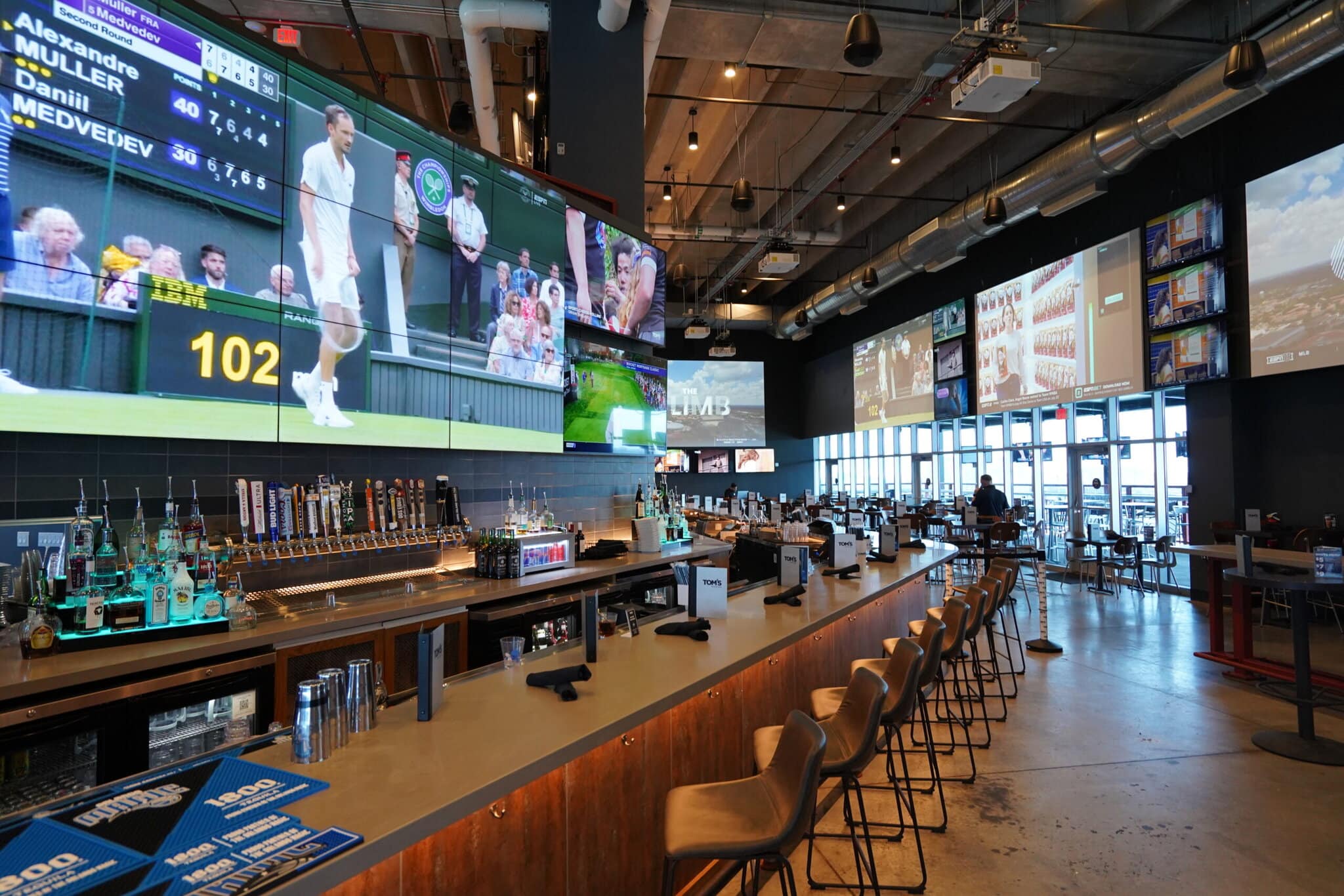A video wall is a large-format display made by arranging multiple screens edge to edge, creating one massive, unified canvas. It’s used in places that need to grab attention or share complex visuals clearly—think live dashboards, digital art, or interactive brand displays.
A popular example would be the control room at NASA’s Johnson Space Center where you’ll see an enormous wall of screens tracking every spacecraft in real-time. Another one is the lobby of the Salesforce Tower in San Francisco and a beautiful floor-to-ceiling digital art display that will welcome and mesmerize you.
At AT&T Stadium in Texas, the giant video wall keeps diehard football fans immersed in every play.
Simply put, video walls have become ubiquitous. Not just in high-stakes environments or sports arenas but in retail stores, corporate offices, and even schools. But what exactly makes video walls so powerful? Why are more industries investing in them?
What is a Video Wall?
A video wall is a large-scale display made by combining multiple screens—such as LCD or LED panels—into one seamless visual experience. Instead of a single TV or monitor, a video wall transforms an entire wall into a dynamic canvas for content, brand storytelling, real-time data, or even interactive touch features.
Built for maximum impact, video walls offer greater flexibility, brightness, and performance compared to traditional screens. They’re designed to deliver immersive experiences in high-traffic environments where grabbing attention matters big time.
You’ll commonly find video walls in corporate lobbies, retail stores, command centers, sports bars, museums, and other public spaces where bold, engaging visuals elevate the environment.
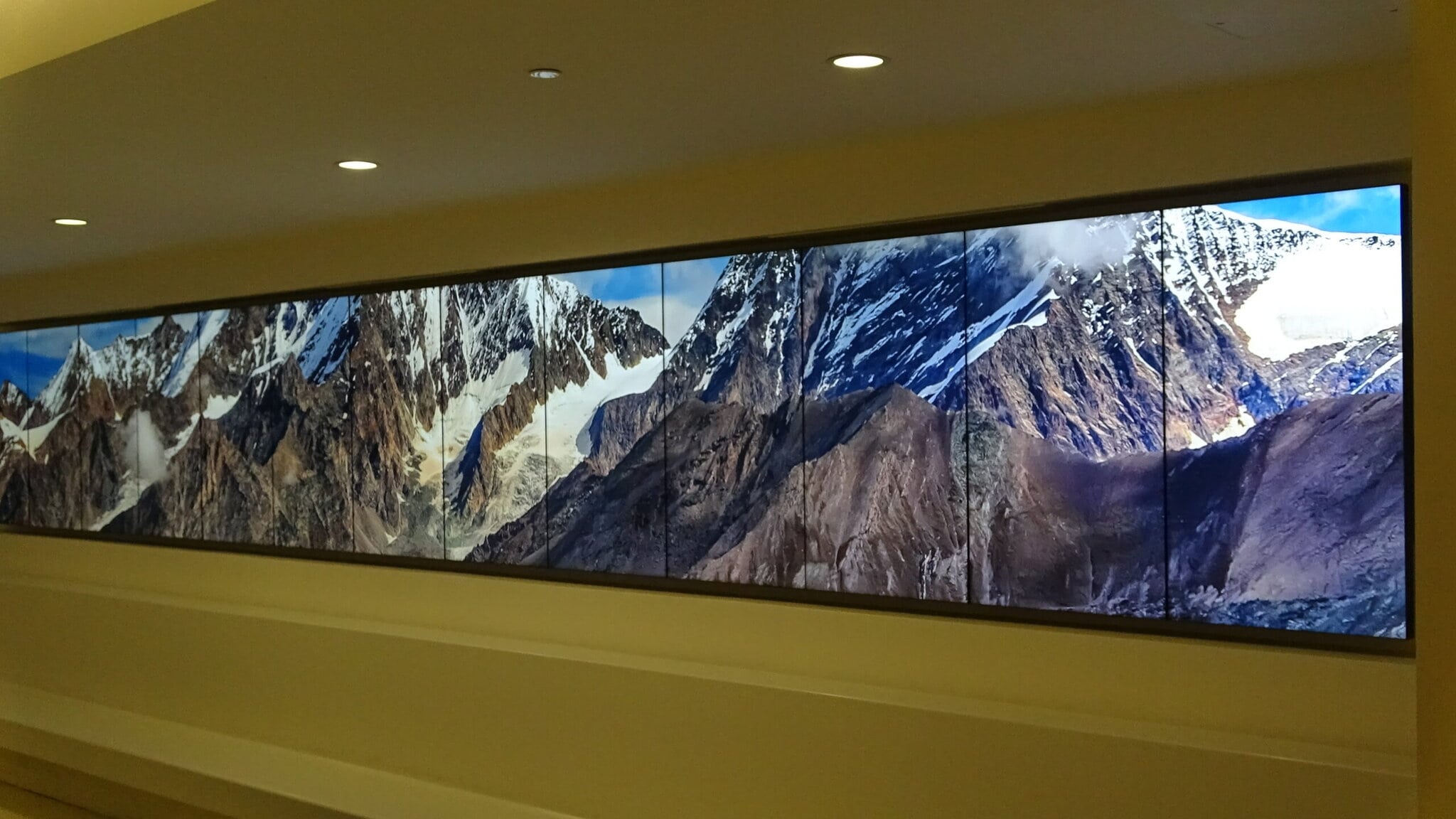
What Is the Purpose of a Video Wall?
Video walls serve a bigger purpose than simply showing a video. Here’s why businesses and organizations invest in them.
Enhanced visual impact
A single screen can only do so much. A video wall delivers large-scale, high-resolution visuals that command attention. The display content is clearer, brighter, and more immersive whether it’s a gigantic digital ad or a real-time data dashboard.
Better engagement and information sharing
Information is easier to process when it’s displayed dynamically. That’s why video walls are used for everything from interactive kiosks to live event coverage. They help businesses communicate their message to employees and stakeholders in such a way that sticks.
Scalability and flexibility
Need a large video display that can grow alongside your needs? Video walls can be expanded, rearranged, or customized in endless ways. Show one large image or multiple feeds at once. Stream live data, social media, or real-time metrics. It’s a level of versatility that traditional screens just don’t offer.
Video Wall Components: What’s Needed?
A video wall is a system where every piece plays a role in delivering a high-quality display. Curious what goes into making it work? Four things mainly:
Display panels
The large screens are the foundation. Options include LCD (liquid crystal display), which offers crisp visuals with thin bezels; and LED (light-emitting diode), known for its seamless design and brightness. Some setups use projection, but that’s less common for modern video walls.
Video wall controller
We can call it the brain of the system. A controller manages how content appears across screens. It allows for real-time adjustments, multiple inputs, and custom layouts. Without it, you’re basically just stacking TVs together.
Software solutions
Software controls everything from scheduling to live data integration. Some platforms allow remote management. That means you can update content from anywhere. The right software turns a video wall into an interactive tool rather than a static, boring display.
Mounting and installation
A video wall needs proper support. That could mean a simple wall mount, a freestanding structure, or a curved installation for an immersive effect. Stability and accessibility are vital especially for maintenance and upgrades.
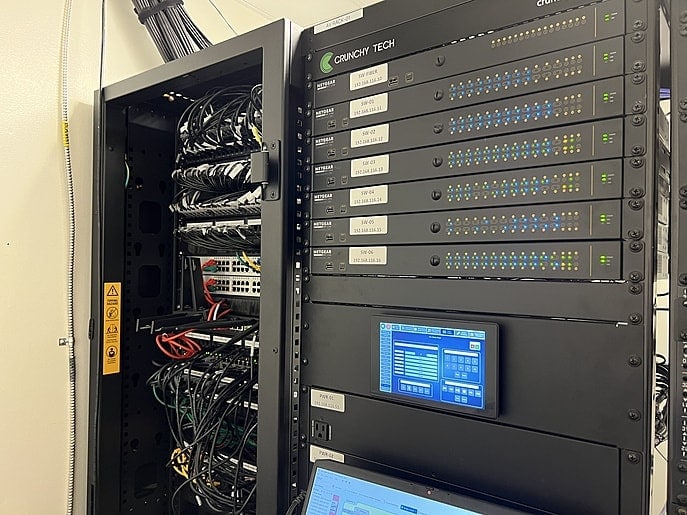
Different Types of Video Walls
Not all video walls are the same. The right choice depends on budget, environment, and how the large display will be used. Below is a breakdown of the most common types.
LCD video walls: A popular choice for businesses and control rooms. LCD panels offer high definition imagery and affordability but come with visible bezels where screens meet. Best for indoor environments where seamlessness isn’t the chief priority.
LED video walls: For a perfectly seamless display, high resolution LED monitors are your best bet. These panels are bright, bezel-less, and work well even in outdoor settings. They cost more upfront but last longer and provide superior image quality.
Projection video walls: Less common but still used in some large venues. Instead of several screens, a projector casts an image onto a display surface. These setups are cheaper but necessitate controlled lighting and regular maintenance.
Interactive video walls: Touch-based displays that enable users to engage with content. Wonderful for wayfinding, presentations, and immersive storytelling—whether that’s an interactive shopping wall in a retail store, a corporate lobby installation, or a museum video wall guiding visitors through an exhibit.
Interactive video walls: Touch-enabled displays that invite users to engage with content. They’re used for wayfinding, presentations, and immersive storytelling
Who Uses Video Walls?
Businesses, organizations, and venues across an array of industries invest in them to inform, engage, and attract attention. Here’s where they make the biggest impact.
Corporate and conference rooms
Companies utilize video walls to create compelling presentations, important data visualizations, and for video conferencing. In open offices, they display key metrics, company updates, or live news feeds.
Retail and advertising
Stores and shopping malls capitalize on video walls for eye-catching digital signage and product promotions. Unlike traditional posters, high-definition video walls for retail spaces are more attention grabbing and can potentially help influence buying decisions.
Sports and entertainment
From colossal stadium screens showing live replays to concert backdrops that sync with performances, video walls elevate the fan experience. Theme parks, casinos in Las Vegas, and museums also use them to create marvelous environments.
Command centers and security
Video walls allow security teams, emergency response centers, and network operations hubs to monitor real-time footage and respond accordingly. When every second counts, a clear, centralized display makes a tremendous difference.
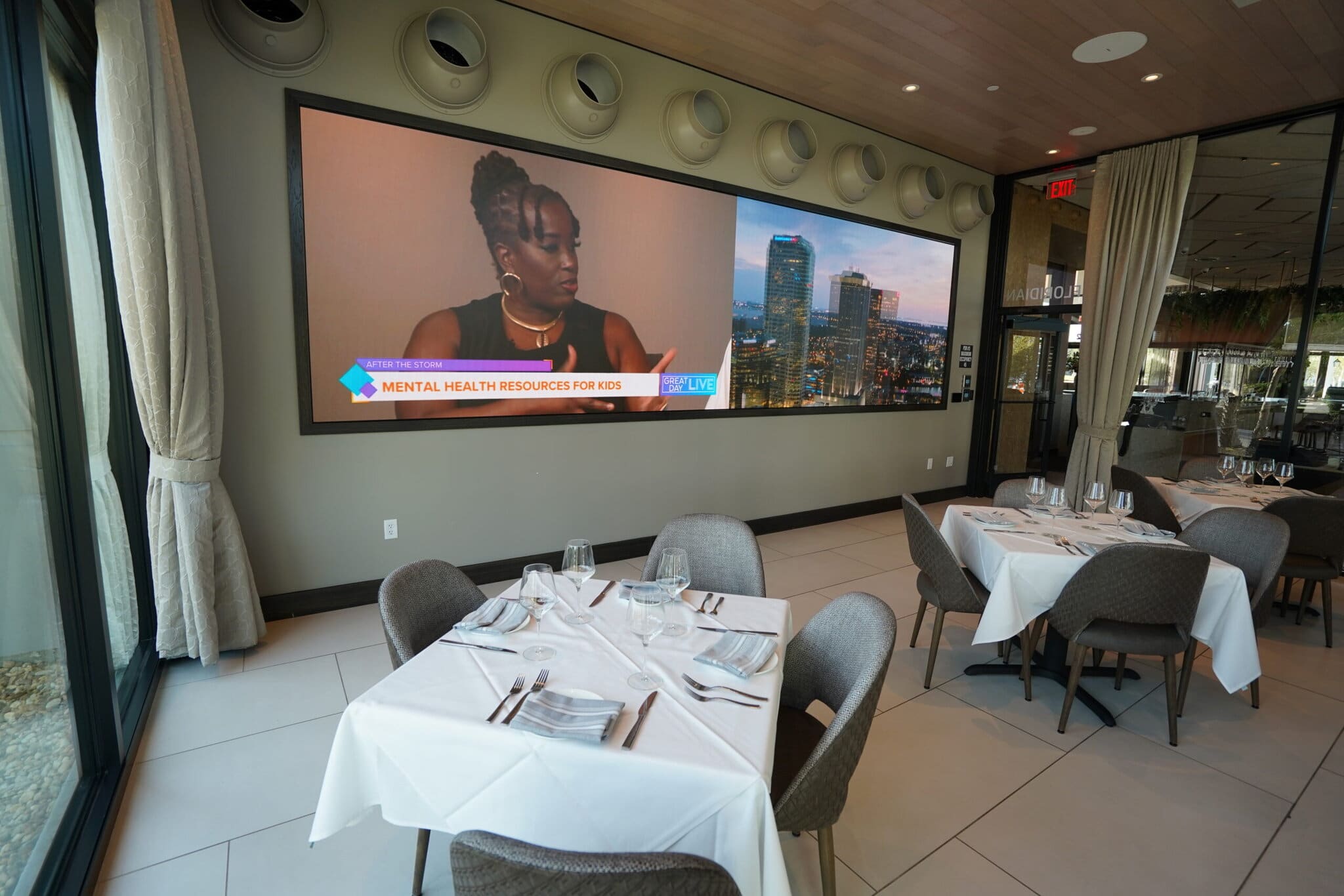
How to Use a Video Wall
Video walls are a flexible tool that can adapt to different needs. Managing content the right way is key whether for advertising, monitoring, or collaboration.
Content management basics
Video walls can exhibit more than just a looping video. Businesses use them for live data feeds, HD video streams, interactive content, and so on. The right video wall software allows users to switch between sources, update content on the fly, and even integrate live broadcasts.
Multi-zone display options
Instead of showing one big image, a video wall can be split into sections, each running a different feed. Security centers display multiple camera angles at once. LED video walls in retail store environments, meanwhile, show ads, product demos, and social media feeds placed adjacent. Event spaces can mix live video with sponsor branding and schedules.
Remote management & automation
Advanced video walls don’t need someone onsite to update them. With cloud-based control systems businesses can sched content changes, adjust layouts, and troubleshoot remotely. It’s recommendable for multi-location businesses and digital signage networks where consistent updates without manual intervention are imperative.
How to Create Video Wall Content
A video wall is only as good as the content it displays. Poorly designed visuals can look pixelated, distorted, or stretched, reducing impact. Master video wall content creation with the following best practices.
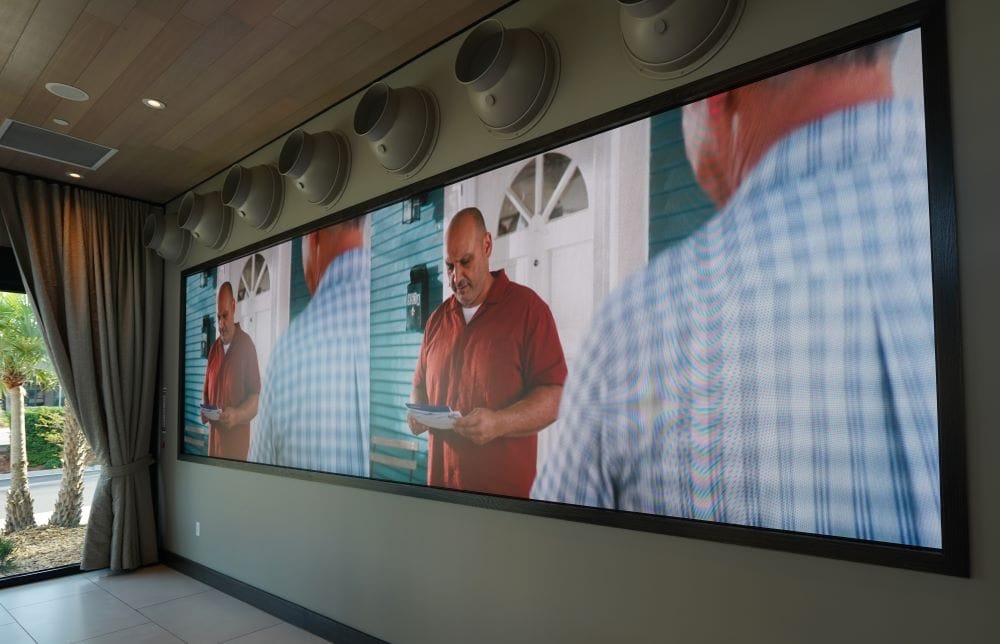
Resolution & aspect ratios
- Match the resolution. Video walls have a much higher resolution than standard screens. Using low-res content will result in blurry, pixelated images.
- Maintain aspect ratios. If your video wall is an ultra-wide 32:9, but your content is formatted for 16:9, it’ll either stretch or leave empty space. Always design content to fit the exact dimensions of your setup.
Dynamic content strategy
A mix of video, motion graphics, and real-time data keeps the display engaging. Consider:
- Looping video clips – For digital signage and brand messaging.
- Live dashboards – Display stock prices, social feeds, or company metrics.
- Event-based content – Update promotions, schedules, or alerts in real time.
Interactive elements
Touch-enabled video walls allow for direct audience engagement. Businesses can integrate:
- Gamified experiences – Encourage interaction at events and trade shows.
- Wayfinding maps – Interactive directories in malls or airports.
- Product showcases – Let customers browse options in retail settings.
Video Wall vs. Traditional Displays
At first glance, a giant TV might seem like a cheaper, simpler alternative to a video wall. But side by side, the differences are hard to ignore. A video wall technology is a smarter, more powerful system programmed for excellent visual performance.
Size and seamlessness
A standard TV maxes out at a certain size. Go too big, and the resolution suffers. Video walls combine multiple high-quality displays into one and scale up without losing clarity. Some are virtually bezel-free and create an edge-to-edge image.
Processing power
A regular TV or monitor runs off its built-in processor. That’s fine for movies or presentations. But it struggles with multiple inputs or live feeds. Video walls use specialized controllers that manage content across all screens for real-time updates, dynamic layouts, and multiple sources all at the same time.
Content customization
A single display shows one thing at a time. A video wall can be divided into sections and show various content simultaneously. Think: live posts, security feeds, advertisements, or event schedules. It’s not just about size but control and synchronization.
LED vs. LCD Video Walls: Which Is Better?
Both LED and LCD video walls have their strengths. Whichever is the right choice heavily relies on where and how you plan to use them. A quick comparison guide:
Seamlessness and bezels
If you fancy a truly seamless display, LED technology is hands down the winner. LED panels have little to no bezels so content flows smoothly across the entire surface. LCD screens have visible borders between panels, which can break up the image, though ultra-thin bezel options help reduce this effect.
Brightness and outdoor use
LED video walls are made to thrive in bright environments, e.g., direct sunlight. They offer higher brightness levels, better contrast, and are ideal for outdoor billboards, stadiums, and storefronts. LCD screens perform best indoors wherein lighting conditions are more controlled.
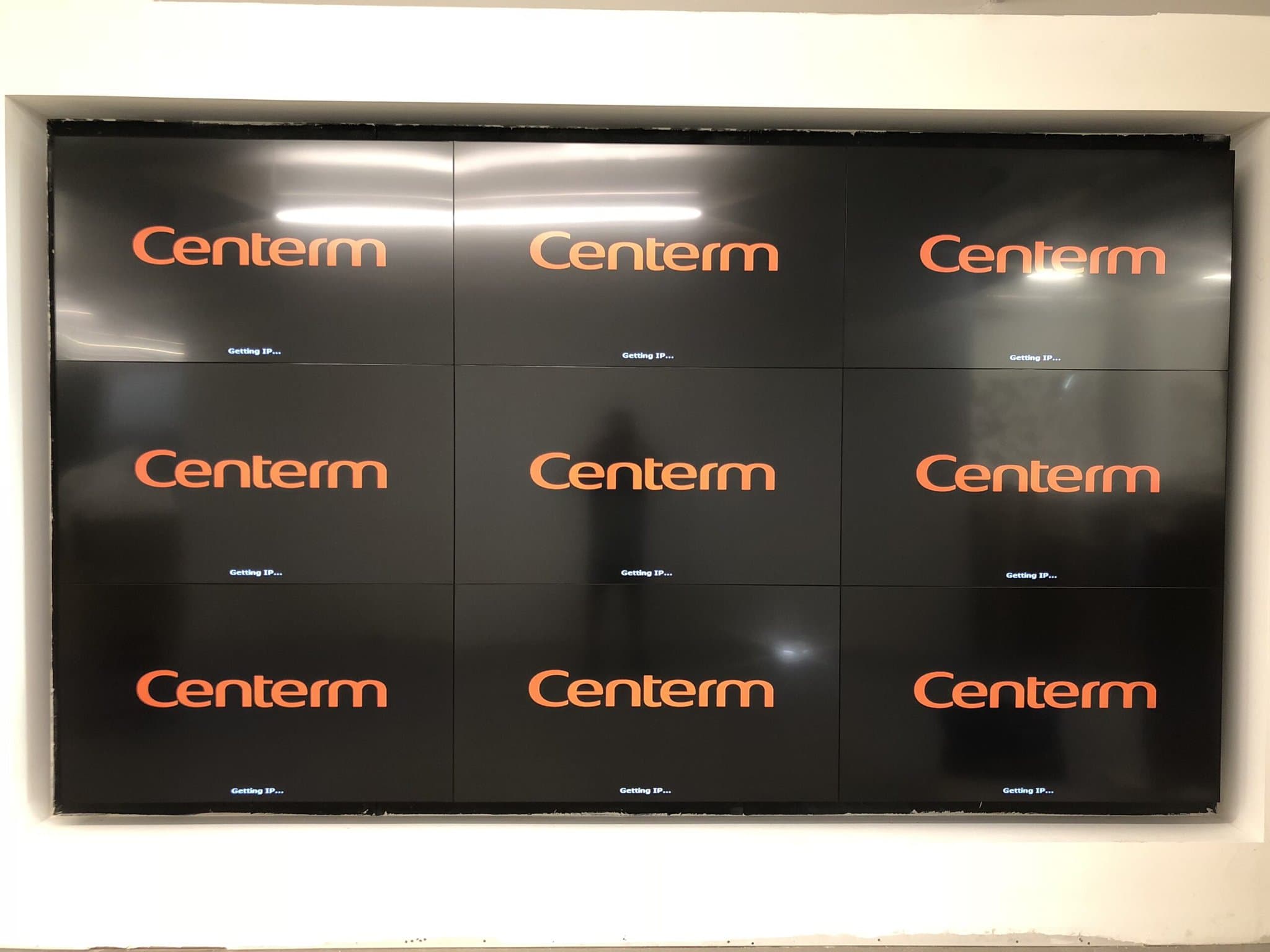
LCD vs LED Video Wall Cost Considerations
LCD video walls are more economical upfront. They provide high resolution at a lower cost so it’s a solid choice for indoor corporate settings, retail stores, and emergency control room video wall systems. LED, while costlier, lasts longer and requires less maintenance over time. This makes it a better long-term investment for large-scale or high-traffic environments.
Here’s how they stack up against each other:
| Category | LCD Video Wall | LED Video Wall |
|---|---|---|
| Cost per Square Foot | $600–$1,000+ | $1,300–$2,700 |
| Typical Display Size | 46″–55″ panels tiled together | Modular panels, customizable to any size |
| Total Cost for Medium Wall (approx. 9′ x 5′) | $20,000–$41,000 (hardware + basic install) | $68,000–$162,000+ (depends on pixel pitch and complexity) |
| Installation Cost | Moderate ($2,700–$6,750) | Higher ($5,000–$15,000) |
| Maintenance Costs | Moderate (panel replacements, color calibration) | Lower long-term (individual module repair) |
| Lifespan | ~50,000 hours | 80,000–100,000 hours |
| Brightness | ~500 nits (indoor standard) | 800–5,000+ nits (indoor and outdoor options) |
| Seamlessness | Visible bezels between panels | Seamless, no visible gaps |
| Typical Use Cases | Corporate lobbies, boardrooms, control rooms | Stadiums, malls, broadcast studios, premium lobbies |
Video Walls vs. Projectors
Video projectors used to be the go-to for big display technologies, but video walls have changed the game. The differences are crystal clear especially in terms of visibility, maintenance, and long-term value.
Brightness and clarity
Projectors struggle in bright environments. Even high-lumen models lose contrast in rooms with natural light. They make images look washed out.
LED-based video wall systems stay sharp and vivid no matter the lighting conditions. They also offer higher reso; while projectors can look blurry when stretched across large surfaces.
Longevity and maintenance
Traditional projectors rely on bulbs or laser sources that eventually dim and need regular replacements. Accumulated dust and excessive heat can wear them down faster.
Video walls are built for continuous use. With LED panels lasting up to 100,000 hours (or 11 years) before needing major maintenance.
Cost vs. ROI
Projectors cost less initially but the ongoing expenses—e.g., bulb replacements, cleaning, recalibration—add up. Video walls demand a larger investment, but lower maintenance and greater durability make them undoubtedly a smarter long-term choice.
Plus, the top-tier brightness and clarity lead to better engagement making them more effective in commercial and business settings.
Video Wall Size & Customization
Video walls can be as compact as a 2×2 grid or stretch across an entire building like those in Times Square in New York City. The right size can be determined by space, purpose, and viewing distance.
Common sizes
The most common video wall configurations are:
- 2×2 (Four screens) – A great starting point for conference rooms, control centers, or small offices and retail spaces.
- 3×3 (Nine screens) – Provides more impact, commonly used in lobbies, broadcast studios, and command centers.
- 4×4 (Sixteen screens or more) – Ideal for large-scale displays in airports, stadiums, and corporate headquarters.
Custom layouts
Video walls don’t have to be simple grids. Businesses use curved, ultra-wide, and even artistic layouts to create immersive environments. Think of an LED wall wrapping around a stage. Or a towering vertical display in a luxury retail store. Custom shapes and sizes let brands stand out and make a statement.
Scaling considerations
Bigger isn’t always better. A video display wall should match:
- Content quality – Low-resolution content stretched across a huge display looks pixelated. High-quality visuals are an absolute must.
- Room size – A massive display in a small office space can overwhelm viewers.
- Viewing distance – The farther people are, the larger the screens need to be.
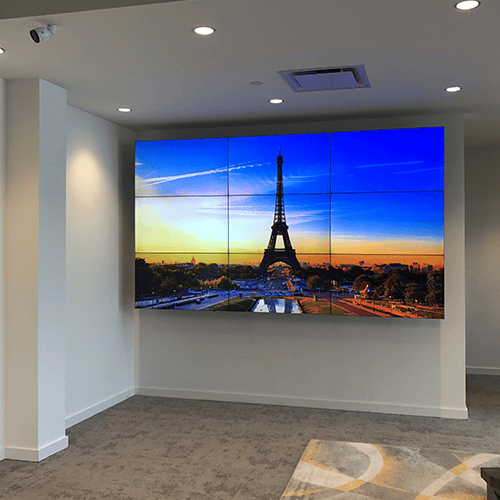
Potential Drawbacks of Video Walls
Video walls offer incredible visual impact. But they’re not always the right fit for every situation. A few challenges to consider before making the investment include:
Higher initial cost
Compared to a single large TV or a projector, it requires multi-screens, a controller, mounting hardware, and professional video wall installation. The upfront cost is considerably higher (though the long-term durability and performance often justify the investment).
Installation complexity
Mounting and installing a video wall is NOT a DIY project. Proper alignment, structural support, and cabling all demand the expertise of experienced AV technicians and engineers. Otherwise it can lead to uneven seams, overheating, or connectivity failures.
That’s why professional installation is pretty much a must.
Content creation requirements
Standard videos and images don’t always look right on a multi-screen display. To maximize impact, content often needs to be designed for the specific layout. It could be a single large image stretched across multiple screens or different sections displaying unique content. This can mean extra laborious effort in design and formatting.
Can You Use Regular TVs for a Video Wall?
Technically? Yes. But while it might seem like a cost-saving shortcut, regular TVs aren’t exactly built for video wall setups.
Unlike professional video wall panels, standard TVs lack built-in processors for managing multi-screen content.
That is, you’ll need external hardware and complex configurations to sync several screens properly. Also, most TVs have thicker bezels. It’s highly likely there’ll be noticeable gaps between screens.
Durability & brightness issues
Regular TVs aren’t made for 24/7 operation. Their cooling systems and internal components can’t adequately handle extended use. It can lead to overheating, screen burn-in, and shorter lifespans. They also lack the brightness + anti-glare coatings found in commercial-grade video displays. It’d be harder to see in well-lit environments.
Alternative solutions
Instead of repurposing TVs, businesses should invest in professional-grade display panels designed specifically for video walling. These screens offer ultra-thin bezels, higher brightness levels, and built-in video wall processing for top-notch visuals and long-term reliability.

Video Wall FAQs
What is video wall mode?
Video wall mode facilitates multiple screens to function as a single, unified display or show various content on each screen. A video wall processor or specialized software controls how visuals are arranged, whether stretched across all screens or divided into separate sections.
Settings can be adjusted through hardware controllers or software so users can schedule content, resize visuals, optimize display quality, etc.
Can video walls be used outdoors?
Certainly, but they require weatherproofing and high brightness levels among other things. Outdoor LED video walls are designed to withstand rain and extreme temperatures while still maintaining visibility in direct sun exposure.
Do video walls need special software?
Yes, video walls require content management software to handle multi-screen layouts, real-time updates, scheduling, etc. Some systems use hardware controllers. Others rely on cloud-based video walls or local software solutions.
How much does a video wall cost?
Prices depend on size, display type, and resolution. If you’re going for a smaller setup, LCD video walls are the budget-friendly choice. LED video walls entail higher cost but they make up for the fact that they last longer and offer better quality, especially with higher pixel density.
What is the lifespan of a video wall?
In most cases, LCD video walls last between 30,000 and 50,000 hours or around 6 years with regular use. LED video walls boast nearly double the lifespan of its LCD counterpart with 80,000 to 100,000 hours (up to 11 years), and with less maintenance requirements on top of that.
What is pixel pitch?
Pixel pitch refers to the distance (in millimeters) between the center of one pixel and the center of the next on an LED display. It’s a key factor in determining how sharp and clear your video wall will look especially up close. It impacts purchase decisions because lower pixel pitch costs more but delivers better visuals for close viewing.
Higher pixel pitch is more affordable and ideal for displays viewed from farther away. Picking the right one ensures you’re not overpaying—or underdelivering—on image quality.
Can a video wall display different content on each screen?
Video walls support multi-zone layouts and allow different content sources on each screen. This is useful for:
- Security centers (multiple camera feeds).
- Retail displays (ads, promotions, live feeds).
- Corporate dashboards (KPIs, news, and social media feeds).
How do I maintain a video wall?
The most basic is regular cleaning with microfiber cloths and non-abrasive cleaners. For the software, make sure to keep content management systems and firmware updated. Lastly, check connections, recalibrate alignment, and monitor brightness levels.
What industries benefit the most from video walls?
Video walls are a captivating visualization tool for corporate presentations, retail marketing, and in sprawling venues such as sports centers and entertainment hubs. Video walls are also highly beneficial and used in medical facilities, hospitality, public transport, government, and universities.
Get Custom Video Wall Solutions with Crunchy Tech
Your space isn’t like anyone else’s, so your video wall shouldn’t be either. Maybe you need a massive digital display to grab attention or an interactive setup that pulls people in. Whatever the goal, it should work for you.
Crunchy Tech handles everything—design, installation, content setup, and long-term support—so you don’t have to stress over the details. Let’s make it happen. Get a video wall that does exactly what you need it to. Talk to our AV experts today.
